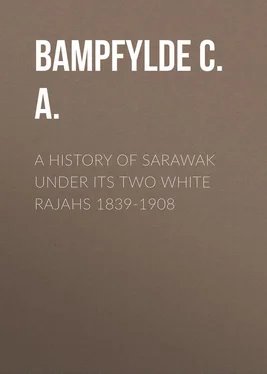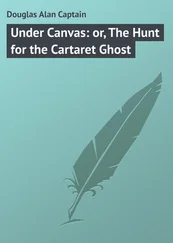C. Bampfylde - A History of Sarawak under Its Two White Rajahs 1839-1908
Здесь есть возможность читать онлайн «C. Bampfylde - A History of Sarawak under Its Two White Rajahs 1839-1908» — ознакомительный отрывок электронной книги совершенно бесплатно, а после прочтения отрывка купить полную версию. В некоторых случаях можно слушать аудио, скачать через торрент в формате fb2 и присутствует краткое содержание. ISBN: , Жанр: foreign_antique, foreign_prose, на английском языке. Описание произведения, (предисловие) а так же отзывы посетителей доступны на портале библиотеки ЛибКат.
- Название:A History of Sarawak under Its Two White Rajahs 1839-1908
- Автор:
- Жанр:
- Год:неизвестен
- ISBN:http://www.gutenberg.org/ebooks/52873
- Рейтинг книги:4 / 5. Голосов: 1
-
Избранное:Добавить в избранное
- Отзывы:
-
Ваша оценка:
- 80
- 1
- 2
- 3
- 4
- 5
A History of Sarawak under Its Two White Rajahs 1839-1908: краткое содержание, описание и аннотация
Предлагаем к чтению аннотацию, описание, краткое содержание или предисловие (зависит от того, что написал сам автор книги «A History of Sarawak under Its Two White Rajahs 1839-1908»). Если вы не нашли необходимую информацию о книге — напишите в комментариях, мы постараемся отыскать её.
A History of Sarawak under Its Two White Rajahs 1839-1908 — читать онлайн ознакомительный отрывок
Ниже представлен текст книги, разбитый по страницам. Система сохранения места последней прочитанной страницы, позволяет с удобством читать онлайн бесплатно книгу «A History of Sarawak under Its Two White Rajahs 1839-1908», без необходимости каждый раз заново искать на чём Вы остановились. Поставьте закладку, и сможете в любой момент перейти на страницу, на которой закончили чтение.
Интервал:
Закладка:
Sharks of several species abound, but cases of injury by these are very rare.
Saw-fish are also common, and with their long spiny saws are dangerous creatures. A fisherman was killed by one of these at the mouth of the Sadong; he was in a small canoe when the fish, which he had cut at with his knife, struck him a blow on his neck with its saw, from which he died almost immediately.
Excellent fish are abundant, such as mackerel and herring, considerably larger than the English varieties, pomfret, barbel, soles, mullets, etc., and some of beautiful colours; also crabs, prawns, and oysters. The dugong (Malay duyong), the sea-cow, is rare in Sarawak, but common in North Borneo, as is also the whale; in Sarawak the latter are occasionally stranded on the beach. Turtles abound; these are preserved for the sake of their eggs, which are considered a great delicacy.
We will now consider the races that occupy Sarawak territory; and the following brief ethnological notes with regard to those of Indonesian stock will be all that is necessary for the purposes of this book; to attempt anything like an accurate classification of the many tribes and sub-tribes which differentiate the heterogeneous population of the country would be beyond its scope, even were it possible to trace the divergence of the cognate tribes from the original stock, and of the sub-tribes from the tribes. That there may have been earlier inhabitants of Borneo than those now existing in the island is possible. Traces of neolithic man have been found, but these may be due to the first settlers having brought with them stone weapons cherished as charms. Of paleolithic man not a trace has been discovered. 17 17 "Mr. St. John ( Forests of the Far East , p. 190) mentions stones or pebbles of a dark colour considered by the natives as sacred. Some such, found at Quop, were said to have been lost during the civil wars. They are possibly paleolithic implements." – Beccari, op. cit. p. 367.
To attempt to determine the flow of mankind into the country, or to decide which of the tribes of Indonesian stock now found in Sarawak was the first to occupy the soil, is to undertake an impossible task. 18 18 The late Rajah wrote in 1838: "We know scarcely anything of these varieties of the human race beyond the bare fact of their existence." We have since learnt something of their languages and customs; of their origin nothing.
It may be accepted that the most barbarous peoples, the Ukits, Bukitans, Punans, and other fast vanishing tribes, were the earliest inhabitants of whom we know anything, and that they were immigrants. But whence they came we know not. These tribes are all more or less related in language and customs, and in Borneo difference in names does not always denote any essential racial distinction.
As an instance of this we have the Lugats, of whom only a very few are left, the Lisums, the Bliuns, a tribe that has quite died out, the Segalangs, and the Seru Dayaks of the Kalaka, a tribe which is fast disappearing. The above sub-tribes take their name from rivers widely apart, and though their names differ they are of the same race, sub-tribes of the Ukits. Their tradition is that three or four hundred years ago the Ukits lived in the Lugat (now the Gat) river, a branch of the Baleh (hence we have the Lugats now living in the Anap), but they were driven out by the Kayans. Some went to the Lisum river (hence we have the Lisums), and some to Kapit, where they built strong houses on the site of the present fort, but these they were eventually forced to evacuate, and again they migrated down river, first to Tujong, near the Kanowit, and afterwards farther down again to Bunut, by Benatang. From Bunut they were driven out by their implacable foes, and they dispersed to Segalang (in the Rejang delta), to Bliun (in the Kanowit), and to Seru in the Kalaka. 19 19 Mr. F. D. de Rozario. The Sarawak Gazette , September 2, 1901. Mr. de Rozario, the officer in charge of Kapit Fort, has been in the Government service for some fifty years, of which nearly all have been spent in the Upper Rejang, and his knowledge of the natives, their customs and languages, is unique.
This tradition is supported by the strong evidence of language, and there is little reason for disregarding it. After being driven out of Lugat, some of the Ukits went over to the Kapuas, where, as in the Baleh, to which river some eventually returned, they are still known as Ukits. The Bliuns, Segalangs, and Serus became civilised owing to contact with the Malays and Melanaus. The Ukits, Bukitans, and Punans, with the exception of the Punan Bah of Balui, are the wildest of all the races in the island. The Ukits are light in complexion; tall and well knit, and better looking than other inland tribes. Formerly they did not reside in houses, or cultivate the soil, but roamed about in the jungle, and subsisted on wild fruit and the animals they killed. But some of these have begun to erect poor dwellings, and do a little elementary farming. They are expert with the blow-pipe, and in the manufacture of the upas-poison, with which the points of their needle-like arrows are tinged. But it is quite open to question whether these poor savages may not be a degenerate race, driven from their homes and from comparative civilisation by more powerful races that followed and hunted them from their farms to the jungle. Beccari ( op. cit. p. 363) says that they "are savages in the true name of the word, but they are neither degraded nor inferior races in the series of mankind. Their primitive condition depends more than anything else on their nomadic or wandering life, and on the ease with which they live on the produce of the forests, and on that of the chase which the sumpitan (blow-pipe) procures for them. This has no doubt contributed to keep them from associating with their fellow-beings, and from settling in villages or erecting permanent houses. I believe that these, although they must be considered as the remnants of an ancient Bornean people, are not descended from autochthonous savages, but are rather the present-day representatives of a race which has become savage." And Beccari is of opinion "that it is difficult to deny that Borneo has had older and perhaps more primitive inhabitants." The natives have legends of former races having occupied the land; the most powerful were, according to the Punans, the Antu-Jalan, who lived in the Balui, around the mouth of the Belaga, where the fort of that name now stands. They disappeared, but have now returned in the persons of the white men. So the Punans believe, and other tribes hug other myths. These savage people are, or rather were, the bitter enemies of the Dayaks, and a terror to them. Silently and unperceived, they would steal on their hereditary enemies whilst these latter were collecting jungle produce, or employed on their farms, and wound them to death with their poisoned arrows.
In former days, when they were more powerful, the Bukitans would openly attack the Dayaks, and as late as 1856 they destroyed one of the large communal Dayak houses on the Krian, and also attacked the Serikei Dayaks. The Ukits do not take heads, and the Punans do not tattoo. The latter and the Bukitans are clever makers of rattan mats, which are in demand by Europeans and Chinese. The Ukits and the Bukitans reside on the upper waters of the Rejang, Baleh, and Kapuas; and the Punans in the Baram and Balui.
The Banyoks and the Seduans are, like the Segalangs, with whom they have intermixed, probably off-shoots of the Ukit tribe. They have recently merged, and occupy the same village in the Rejang below Sibu fort. Like the Tanjongs and the Kanowits they are clever basket makers.
The Sians, another off-shoot of the Ukits, live below Belaga fort. 20 20 See note 2, page 18 .
All these small tribes inhabiting the interior, though a few are found near the coast, are dwindling away, mainly in consequence of in-and-in breeding. Of some of the tribes of the same stock only a few families are left, and in others only a few people, while one or two have totally disappeared within quite recent years.
Читать дальшеИнтервал:
Закладка:
Похожие книги на «A History of Sarawak under Its Two White Rajahs 1839-1908»
Представляем Вашему вниманию похожие книги на «A History of Sarawak under Its Two White Rajahs 1839-1908» списком для выбора. Мы отобрали схожую по названию и смыслу литературу в надежде предоставить читателям больше вариантов отыскать новые, интересные, ещё непрочитанные произведения.
Обсуждение, отзывы о книге «A History of Sarawak under Its Two White Rajahs 1839-1908» и просто собственные мнения читателей. Оставьте ваши комментарии, напишите, что Вы думаете о произведении, его смысле или главных героях. Укажите что конкретно понравилось, а что нет, и почему Вы так считаете.












